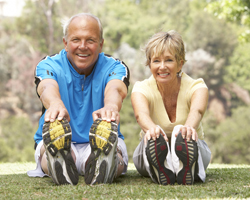Osteoporosis: Part 3, Living with Osteoporosis

Preventative treatment is always best, but what if you’ve already been diagnosed with Osteoporosis? In the final post of our Osteoporosis Series we’ll be addressing what you can do if you’ve already been diagnosed. It’s never too late to give yourself and your body the TLC it deserves!
When people hear the word “osteoporosis” the first two concerns thatusually come to mind are:
- Breaking or fracturing bones
- Loss of height
These two are usually followed by what might be the most damaging thought: FEAR.
The fear of what life will look like with a diagnosis of osteoporosis can lead to emotional and social repercussions. So let’s start off by address that.
It’s important to note that you can still live a full and active life with your condition. There are numerous steps you can take to slow down the progress of losing bone mass. Some theories out there even claim to be able to slightly reverse the disorder.
It’s a fact that negativity breeds negativity while positivity breeds positivity, so let’s look at what you CAN DO instead of what you “can’t do” with a diagnosis of osteoporosis.
Power up on Calcium and Vitamin D: Calcium is needed to build and maintain bone density, while Vitamin D helps your body absorb calcium. In that way they these two go hand in hand. Calcium can be added to your diet via calcium rich foods or supplements (ideally both). Additionally a diet that is high in protein, vitamins and minerals is essential for healthy bones.
Osteoporosis medications: There are two categories of medications for osteoporosis.
- Antiresorptive medications: these slow down the loss of bone mass
- Anabolic drugs: these are said to increase the rate of bone formation.
Talk with your doctor about what medications are good options for you.
Lifestyle Adjustments: Some changes to your home and lifestyle are obvious, like wearing supportive shoes, rearranging protruding furniture, rugs, cords and wires in your home. Others require a professional eye, like adding handrails on both sides of your stairs, repairing floors, steps and more. It’s best to have a professional come to your home and help you make choices to remove hazardous stumbling blocks. Talk to a physical therapist and occupational therapist about adjustments you can make around your home to reduce your risks of falling.
Exercise: Another important factor to living with osteoporosis is to STAY ACTIVE. If you have not led an active lifestyle until now, it’s never too late to start! Yes, you want to make sure that the activities aren’t hazardous to your condition, but avoiding activity to prevent falls can lead you into a trap that you defiantly don’t want to “fall” into.
There are exercise programs geared towards building and maintaining bone density. These “bone health” programs include, high impact or low impact weight bearing exercises, muscle strengthening and non-impact activities to improve balance and posture. Talk with a professional about what exercises best suit you, your condition and your lifestyle.
If you’re having trouble finding the motivation to make these changes to your attitude and your life, find a support group in your community. The power of having people around you who understand your struggle can help tremendously!
